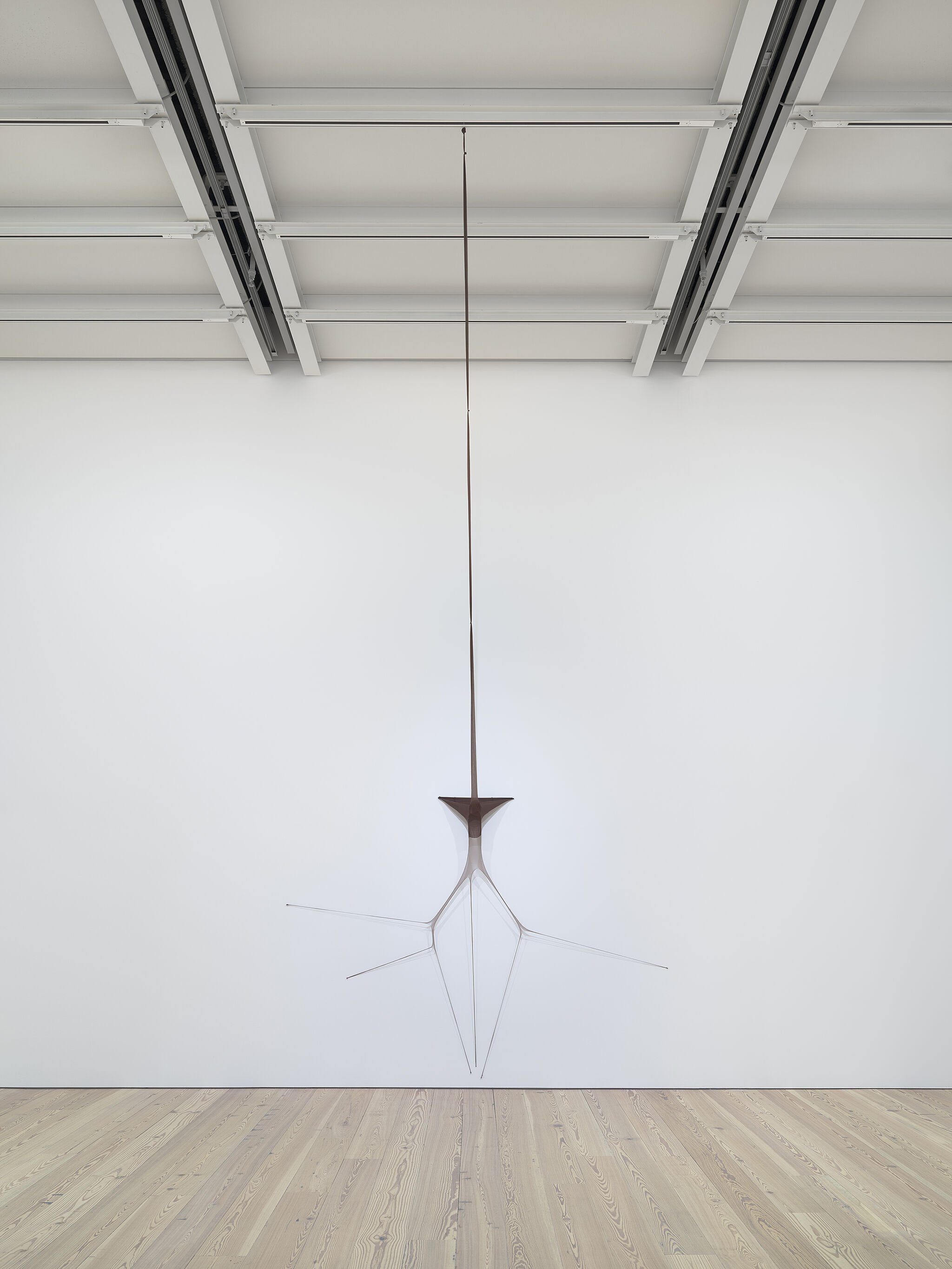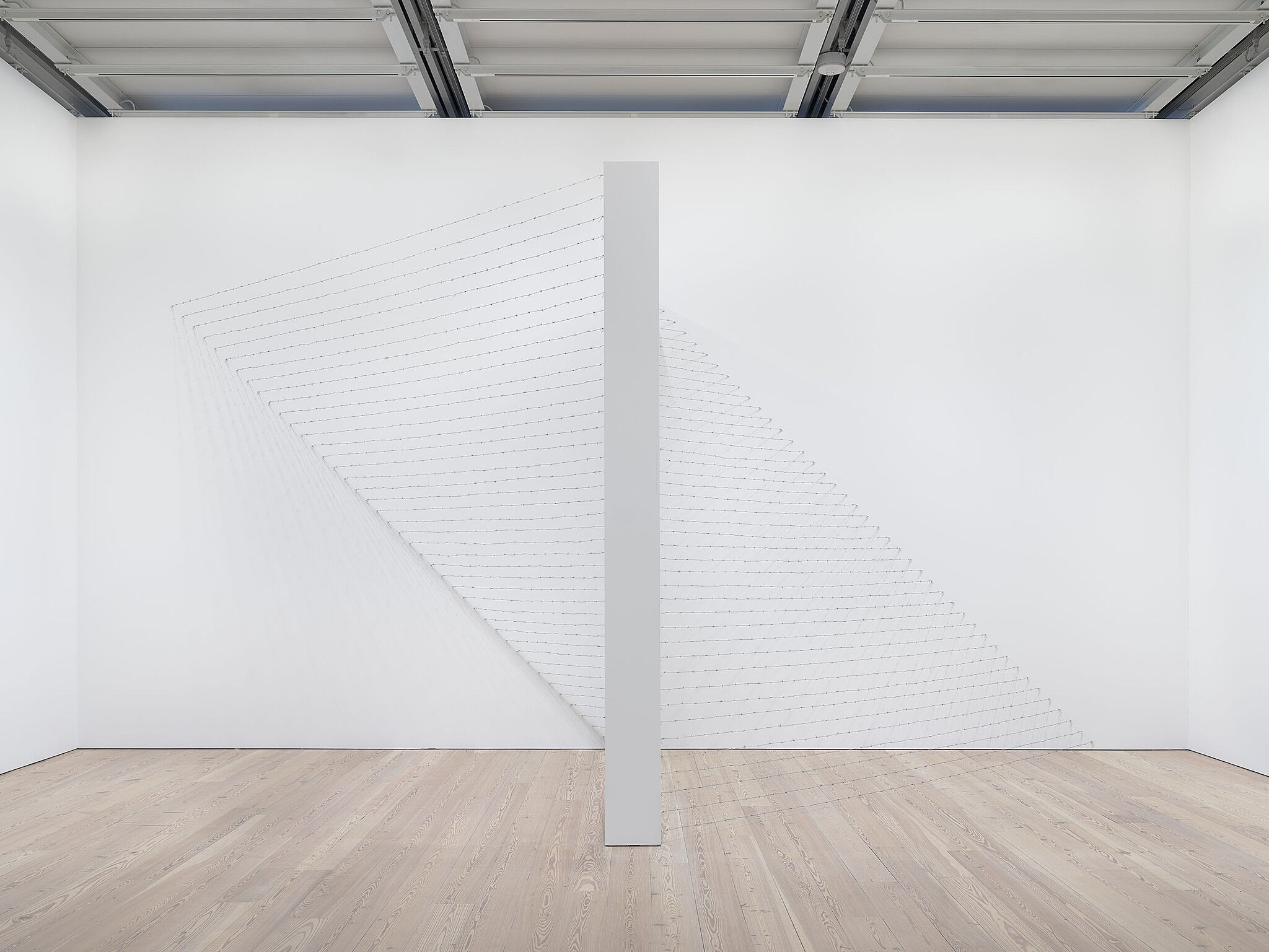An Incomplete History of Protest: Selections from the Whitney’s Collection, 1940–2017 | Art & Artists
Aug 18, 2017–Aug 27, 2018
An Incomplete History of Protest: Selections from the Whitney’s Collection, 1940–2017 | Art & Artists
Spaces and Predicaments
3
Included in the exhibition are two artists who chose personal, oblique, and allusive means to question how social spaces are made, engaged, and controlled. Although working abstractly, Senga Nengudi and Melvin Edwards explore how space can be considered in relation to gender and race.
Made from nylon hosiery, a material that strongly suggests skin, Senga Nengudi’s Internal I (1977) evokes the resilience and fragility of the female body upon entering—and being defined by— society. Its bilaterally symmetrical form calls to mind a human figure that has been brutally stretched and flayed.
Constructed from barbed wire, Melvin Edwards’s Pyramid Up and Down Pyramid (1969) was included in his one-person exhibition at the Whitney in 1970. The work’s material connotes prisons, animal pens, and physical pain within the vocabulary of minimal sculpture. The artist David Hammons remarked of Edwards’s work in the 1970 Whitney exhibition: “That was the first abstract piece of art that I saw that had cultural value in it for Black people. I couldn’t believe that piece when I saw it because I didn’t think you could make abstract art with a message.” Edwards himself said: “All systems have proven to be inadequate. I am now assuming that there are no limits and even if there are I can give no guarantees that they will contain my spirit and its search for a way to modify the spaces and predicaments in which I find myself.”
Artists
- John Ahearn
- Emma Amos
- Richard Avedon
- Rudolf Baranik
- Bastian
- Andrea Bowers
- Mark Bradford
- AA Bronson
- Paul Burlin
- Andrew Castrucci
- Paul Chan
- Mel Chin
- Larry Clark
- Clergy and Laymen Concerned
- Sue Coe
- William N. Copley
- william cordova
- Crash
- Greg Daily
- Allan D'Arcangelo
- Bruce Davidson
- Daze
- Richard Deagle
- Jane Dickson
- Louis H. Draper
- Hock E Aye Vi Edgar Heap of Birds
- Melvin Edwards
- England Free Press
- Avram Finkelstein
- Larry Fink
- Hermine Freed
- Vincent Gagliostro
- Ja'Tovia Gary
- Theaster Gates
- General Idea
- Jeffrey Gibson
- John Giorno
- Leon Golub
- Felix Gonzalez-Torres
- Gran Fury
- Nancy Grossman
- Gross National Product
- Group Material
- Guerrilla Girls
- Keith Haring
- Leslie Hewitt
- Charles B. Hinman
- Jenny Holzer
- International Union of Students
- Rashid Johnson
- Mary Kelly
- Edward Kienholz
- Barbara Kruger
- Kiyoshi Kuromiya
- Suzanne Lacy
- Tom Lafferty
- Lambert Studios, Inc.
- Annette Lemieux
- John Lennon
- Glenn Ligon
- Fred Lonidier
- A. Lunsford
- Michael Lynne
- Daniel Joseph Martinez
- Josephine Meckseper
- Julie Mehretu
- Toyo Miyatake
- Mobilization by the Antioch Bookplate Co.
- Donald Moffett
- Frank Moore
- Peter Moore
- Robert Morris
- Napalm Graphics
- National Peace Action Coalition
- Senga Nengudi
- Louise Nevelson
- New Mobilization Committee to End the War in Vietnam
- Northern California Peace Action Coalition
- Yoko Ono
- Gordon Parks
- Dan Patterson
- Don Peterson
- Irving Petlin
- Howardena Pindell
- Carl Pope
- Pro-Arts, Inc.
- Ad Reinhardt
- Marlon Riggs
- Faith Ringgold
- Kay Rosen
- Martha Rosler
- Robert L. Ross
- Santa Monica Moratorium Committee
- Dread Scott
- Brian Shannon
- Gary Simmons
- Leif Skoogfors, 1940-
- Jaune Quick-to-See Smith
- Jack Sonenberg
- SP/4 Vietnam
- Nancy Spero
- Tom Starace
- May Stevens
- Student Mobilization Committee to End the War in Vietnam
- Carol Summers
- the Gallery
- The Union of Vietnamese in the United States
- Tim Rollins and K.O.S.
- Mierle Laderman Ukeles
- United Women’s Contingent
- Unknown artist
- Various artists
- Vietnam Day Committee
- Vietnam Peace Parade Committee
- Vietnam Referendum '70
- Kara Walker
- William Weege
- David Weinrib
- Irving White
- David Wojnarowicz
- Joseph Wolin
- Women Strike for Peace
- Martin Wong
- Adja Yunkers


